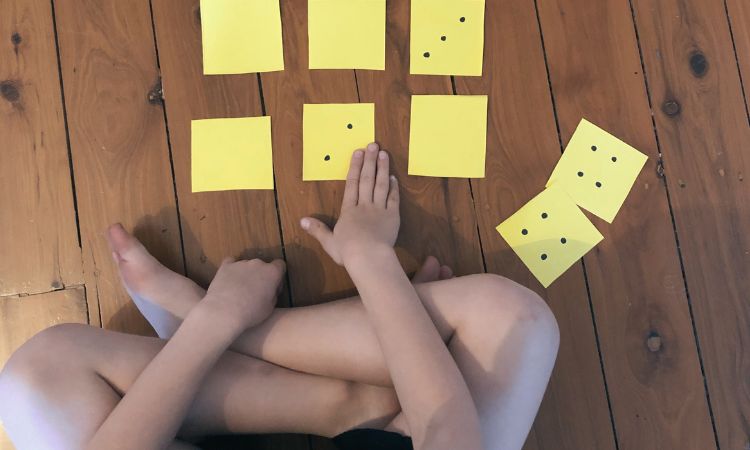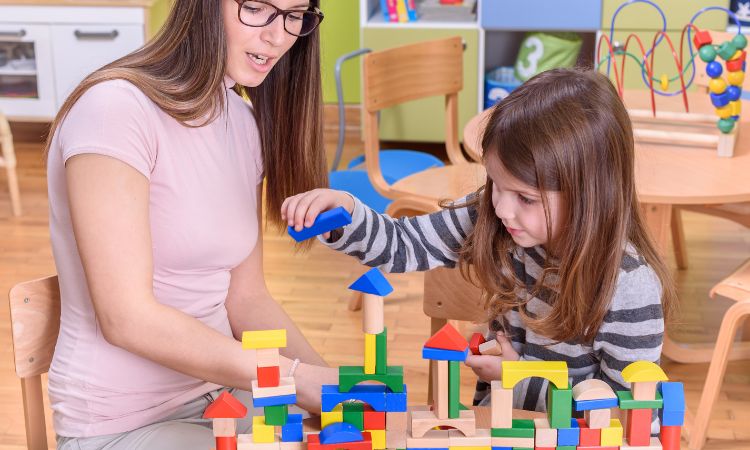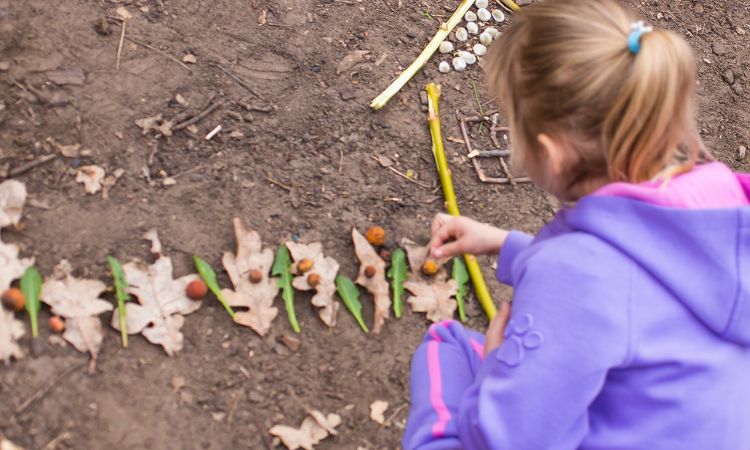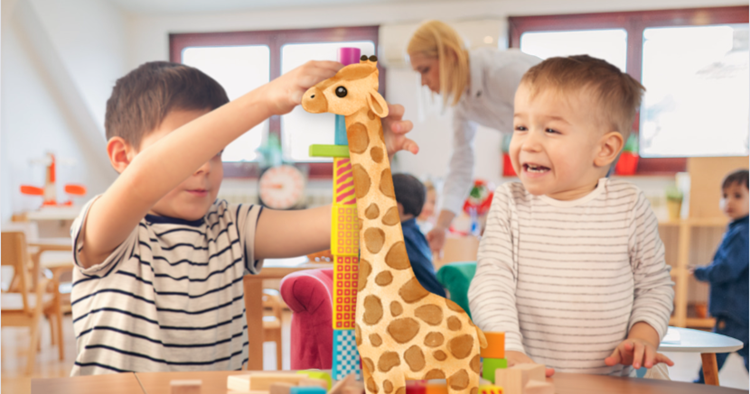Did you know that numeracy learning is an even stronger predictor of life success than literacy?
Research from around the world shows that by the time children start formal schooling, substantial individual difference in mathematical achievement is already evident. In fact, research shows that these mathematical differences predict later achievement (Nguyen et. al., 2016; Seitz & Weinert, 2022). Given the importance of mathematics in the early years, as educators we need to be build our confidence to support this learning with young children through play (Grimmond et al., 2022).
When we think of mathematics in the early childhood environment we often think of numbers and counting. When we learn more about maths and build mathematical content knowledge, we can see it more clearly in play and extend the learning with children.
How mathematics is approached in the EYLF V2.0
“It is essential that the mathematical ideas with which children interact are relevant and meaningful in the context of their current lives" (AGDE, 2022, p. 57).
The EYLF V2.0 highlights the critical role of mathematics in early childhood education. It underscores that being numerate or having the capacity and confidence to use mathematics in daily life, involves not only understanding mathematical principles but also the ability to apply them in contextually relevant and meaningful ways.
This context-driven approach encourages children to develop a genuine interest in mathematics, fostering problem-solving skills by applying mathematics to their everyday lives.
The EYLF V2.0 takes a comprehensive view of mathematics and numeracy, which goes beyond counting and basic arithmetic to encompass a range of more complex concepts and skills. These include understandings about numbers (i.e., number sense), patterns, geometry, measurement, spatial awareness, chance, and data. The framework outlines several crucial mathematical areas children explore including: "spatial sense, geometric and algebraic reasoning, structure and pattern, number sense, data and probability, reasoning and measuring, along with drawing connections and argumentation" (AGDE, 2022, p. 57). It emphasises the development of mathematical thinking and reasoning skills, which can enhance children's academic potential in the future.
4 fun experiences to engage children in mathematical thinking today:
Count and match subitising game
Subitising is the ability to instantaneously identify the quantity of a small group of objects at a glance (without counting). For example, when presented with a collection of dots on a dice face or a series of objects arranged in a pattern, people who have developed subitising skills will know the exact number of items without counting them.
Why is subitising important?
Subitising is considered a fundamental skill in early mathematics development—is a strong predictor of later maths success, and lays the foundation for more advanced number sense and arithmetic abilities.
Learn more about this topic in our upcoming live webinar with CELA Professional Learning Manager Jo Grimmond: More Than Just Numbers: Exploring Number Sense and Subitising Skills in the Early Years
How to play the count and match subitising game
- Prepare a set of cards or small objects with different quantities of dots, such as dice faces, dominoes, or printed cards with dots arranged in patterns.
- Spread out the cards or objects face down on a table or the floor.
- Invite the children to take turns flipping over two cards or objects at a time. The goal is to find a pair of cards or objects that have the same quantity of dots.
- Encourage the children to subitise, or instantly recognise the number of dots, without counting.
- When a match is found, ask the child to say the number aloud and explain how they knew it matched.
- Continue playing until all the matches have been found.

Build and stack spatial reasoning game
Spatial reasoning is the ability to understand and work with things in the space around us. It means being able to picture and manipulate objects in your mind, like imagining how they would look if they were turned or moved. It also involves understanding maps and how things are arranged in relation to each other.
Mapping skills are a part of spatial reasoning and help us represent a space, navigate a building, understand maps, and find our way to a location by figuring out how far places are from each other. These skills are important for things like solving puzzles, learning about position and direction, and understanding shapes and patterns.
Why is spatial reasoning and mapping important?
Both spatial reasoning and mapping skills are crucial cognitive abilities that play a significant role in various domains, including mathematics, engineering, architecture, and navigation. Developing and honing these skills can enhance problem-solving abilities, critical thinking, and overall spatial awareness.
Learn more about this topic in our upcoming live webinar with Jo Grimmond: More Than Just Numbers: Exploring Spatial Reasoning and Mapping Skills in the Early Years
How to facilitate the build and stack spatial reasoning game
- Provide children with various building blocks or construction materials, such as wooden blocks, LEGO bricks, rocks or magnetic tiles.
- Invite the children to use their imagination and creativity to build different structures, such as towers, houses, or bridges.
- Introduce engineering challenges that require spatial reasoning, such as building the tallest tower using only a specific number of blocks or constructing a bridge that can support a toy car.
- Invite the children to think about how the pieces fit together, consider balance and stability, and visualise the structure in their mind before building.
- Encourage them to experiment with different arrangements and observe how changes in positioning and alignment affect the stability and functionality of their creations.
- Discuss and reflect on their designs, asking questions like "Why did you place that block there?" or "How did you make it strong enough to hold up?"
"Build and Stack" allows children to engage in hands-on exploration and problem-solving while developing their spatial reasoning skills. It encourages them to think about spatial relationships, plan their actions, and mentally manipulate objects to create stable and functional structures. 
Nature walk patterning game
Understanding patterning is foundational for the development of mathematical concepts. It involves recognising, copying, creating and extending patterns, describing patterns, and abstracting patterns (i.e., making the same pattern with different objects). A pattern is a sequence or arrangement of elements that repeats or follows a predictable rule. Patterns can be visual, such as colours, shapes, or objects, or auditory, such as sounds or rhythms.
Why is patterning and symmetry important?
In early years numeracy, children explore and work with patterns to understand relationships, make predictions, and develop problem-solving skills. Patterning helps children develop a strong foundation for mathematical thinking and logical reasoning. It also lays the groundwork for more advanced concepts such as algebra and functions.
Symmetry is a key domain in early mathematical understanding of spatial knowledge, and builds on “understandings of reflection and rotation, which often begin to develop through early engagements with patterning “ (MacDonald, 2018, p. 199). Understanding symmetry helps children recognise and appreciate balance, order, and visual relationships. It enhances spatial awareness and critical thinking skills. Early experiences with symmetry can lead to a deeper understanding of geometry and measurement, along with STEM thinking skills which can be fostered through block play.
Through hands-on activities like creating patterns with objects, using pattern blocks or exploring symmetry in nature or artwork, children engage in mathematical thinking and problem-solving. They develop their ability to identify, describe, replicate, and extend patterns, as well as recognise and create symmetrical shapes or designs.
Learn more about this topic in our upcoming live webinar with Jo Grimmond: More Than Just Numbers: Exploring Patterning and Symmetry in the Early Years
How to play the nature walk patterning game
-
Take the children on a nature walk in a park, garden, or any outdoor area with natural elements like trees, flowers, rocks, and leaves.
- Encourage the children to go on a hunt for natural loose parts that could be used to create patterns. Explore a simple pattern with them, such as a sequence of leaf, stone, leaf, stone, leaf, stone (ABABAB pattern). Ask them what comes next in the pattern.
- Ask the children to observe their surroundings and search for objects to create the same type of pattern with different objects that match the pattern (i.e., that is called abstracting the pattern). Support them to discover and extend different patterns using various natural materials they find.
- Play a guessing game by taking an item away from the pattern and encourage them to identify what is missing from the pattern (e.g., stone, stick, … , stick, stone, stick).
- Encourage the children to discuss the patterns they create, identifying the objects and describing the sequence.
For an additional challenge, you can introduce more complex patterns like ABBAABBAA (e.g., rock, rock, leaf, leaf, rock, rock, leaf, leaf, rock).
Let the children take turns creating their own patterns using the natural objects they find. They can challenge their friends to extend the pattern correctly.

Measuring objects game
Measuring skills involve the ability to quantify and compare objects or quantities using standard (formal) and non-standard (informal) units of measurement. Preschoolers can learn to estimate measurements and compare objects using loose parts and materials. For preschoolers, it's best to start by introducing emergent measurement using non-standard units which are informal, everyday objects that can be used to measure other objects. Examples include using blocks, paperclips, or hand spans to measure length, or using cups or small containers to measure capacity.
Using non-standard units allows preschoolers to develop an understanding of emergent measurement concepts, which is foundational for later learning about standardised measurement. Measuring objects in the early childhood environment is fun, engaging and supports learning about measurement in a concrete and relatable way.
Explore this topic further in our upcoming live webinar with CELA Professional Learning Manager Jo Grimmond: More Than Just Numbers: Exploring Measuring Skills in the Early Years
How to facilitate the measuring objects game
- Encourage the children to decide on an object to measure—it could even be each other or a “road” made of blocks.
- Decide on something that could be used to measure it with that can be repeated along the length (e.g., blocks the same length, sticks, straws, boxes, etc). Encourage the children to estimate how many objects it will take to measure. Have a guess yourself and record the predictions.
- Encourage the children to have a turn at measuring with different objects and invite them to estimate each time. Repeat the process with different objects to measure—search for other things to measure in the environment.
- Talk about the discovery and investigation with the children and compare the measurement of the objects.

Conclusion
Introducing early numeracy concepts to preschoolers is vital for their mathematical development, and building our own knowledge is essential for building confidence to notice it in our environments so we can extend it with children and enhance the learning emergent mathematical knowledge builds a strong foundation for future math skills, promotes critical thinking, and develops number sense and problem-solving abilities. Early exposure to mathematical concepts also ensures that children understand the real-world relevance of math in their daily lives, fostering engagement and confidence in their mathematical abilities.
Professional development relating to this topic
References
Grimmond, J., Neilsen-Hewett, C., Howard, S. (2022). The effectiveness of a formative play-based assessment in supporting the early childhood intentional pedagogue. Australian Journal of Early Childhood, 47(4), 304-319.
MacDonald, A. (2018) Mathematics in Early Childhood Education. Oxford University Press
Nguyen, T., Watts, T.W., Duncan, G.J., Clements, D.H., Sarama, J.S., Wolfe, C., & Spitler, M.E. (2016). Which preschool mathematics competencies are most predictive of fifth grade achievement? Early Childhood research Quarterly, 36, 550-560.
Seitz, M., & Weinert, S. (2022). Numeracy skills in young children as predictors of mathematical competence. British Journal of Developmental Psychology, 40 (2), 224 –241.